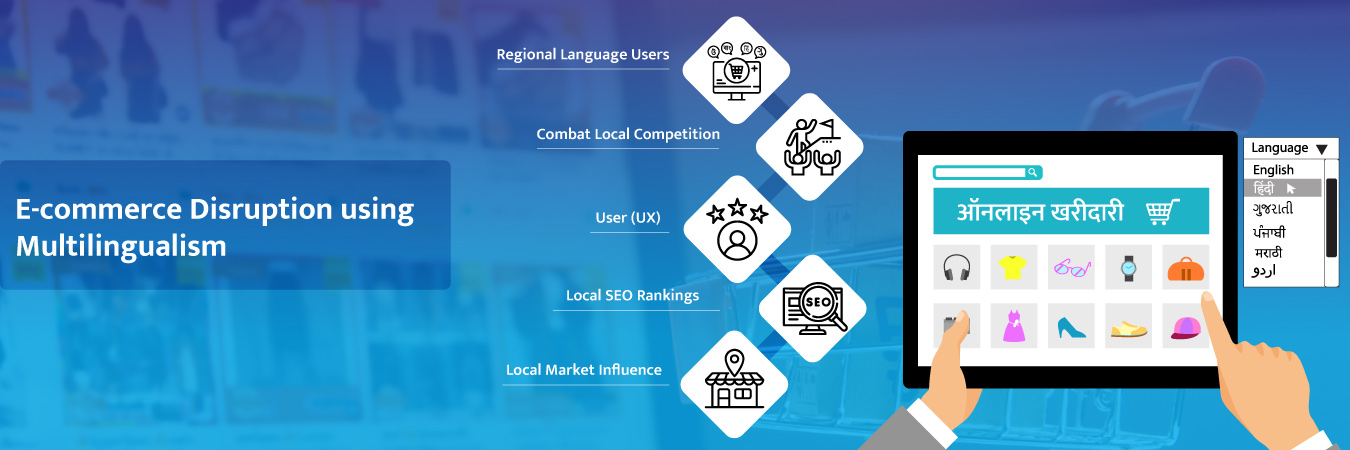
E-commerce Disruption using Multilingualism
E-Commerce is growing and with it competition amongst E-comm companies also growing. E-comm players are finding different ways to remain ahead. Multilingualism can achieve disruptive growth for E-Commerce. The number of regional language internet users is on a continual rise. These represent a demanding and considerable chunk of users, which E-Commerce companies cannot ignore. So, local language content isn’t merely necessary but crucial from the viewpoint of regional market penetration, business, and sustainability in its entirety.
But what indicates the importance of regional languages in E-Commerce? It is the online buyers’ solid language preference. For instance, in Europe, approximately 40% of people never shop online in a language other than theirs. On the other hand, about 33-35% of Canadian online shoppers feel French content drives them to an E-Commerce website. The number is significantly larger in Quebec!
5 Reasons Multilingualism is Crucial for E-Commerce
Let’s examine why multilingualism is a vital aspect of E-Commerce.
1. Number of Regional Language Online Shoppers
Let’s consider the example of India. With its massive internet population, India is one of the largest markets for global E-Commerce players. So, they simply cannot ignore regional language users from tier 2 and tier 3 cities that constitute about 50-65% of their customer base. Let alone new users are added almost every day!
Per reports, well over 70% of Indians prefer non-English content. So, E-Commerce companies that thrive on online sales cannot afford to ignore such a massive chunk. No wonder global E-Commerce giant Flipkart rolled out Marathi in its platform in August 2022. On the other hand, Amazon introduced Bengali and Marathi to its local language list and announced Hindi voice shopping last year.
Thus, if E-Commerce players look to survive in multilingual markets, speaking the market’s language should be part of the company’s marketing plan. But the going gets even tougher while dealing with excessively localized markets like India. Here, it isn’t only one recognized language but hundreds that have equally promising and crucial markets. Thus, a more comprehensive approach and significant investments in creating content in multiple languages can help.
2. Combat Local Competition
Global retail E-Commerce, valued at around USD 4.8-5 trillion in 2021, is projected to reach well over USD 7 trillion in the next two to three years. But this market figure also takes the local players into account.
So, one cannot discount the role local market E-Commerce players play in global E-Commerce. But to compete with them effectively, foreign players should localize content and provide shopping options and product insights in local languages.
3. Shoppers’ Comfort and Experience
While growth and numbers matter, what’s also equally important is shoppers’ comfort and the overall experience they buy. Language has always served as a bridge between cultures and brought people closer. It helps strike a connection between two individuals. Brands and users also aren’t an exception to it.
Users tend to connect with brands that speak their language. They feel comfortable while reading content in their language. It helps them better understand what they are buying, comprehend instructions and make informed decisions. It can also expedite the lead-to-sales process.
Thus, local language content and a delightful user experience can help E-Commerce companies retain buyers and compete better.
4. Local SEO Rankings
Local SEO rankings are another crucial factor determining multilingualism’s role in E-Commerce. Google loves user-centric brands and websites that provide local language content to their users. SEO localization or localizing content for local or hyperlocal SEO can help websites rank better across local languages or local searches. It can boost leads that could stand a greater chance of conversion when they find high-quality, relevant, and accurate local content.
5. Build Local Market Influence
Building local market influence certainly takes time, and the road to it isn’t as straightforward either. Local market players have a solid hold over their target segments; penetrating them isn’t as easy for an outsider.
But multilingualism can help do that. Of course, it isn’t a magic stick that will turn things around overnight. But with consistency and rich and resonating content, building local market influence wouldn’t remain as challenging.
Localize Your Online Store with FidelSoftech!
Are you an E-Commerce company looking to penetrate regional markets and localize your website or mobile app? Partner with Fidel Softech! With expertise in over 100 Indian and foreign languages, Fidel Softech can help you leverage the language medium effectively to connect with your regional users.
Our services include everything from translation to complete localization to help you compete effectively in the regional context. We employ regional language experts and E-Commerce SMEs, who work closely to create content that catalyzes regional market success in the long run.
Local markets constitute a significant business playground for E-Commerce players. So, don’t struggle or lose local market opportunities. Tap them with localization. Connect with us at +91-20-49007800 or write an email to sales@fidelsoftech.com to make it big in the regional market.
Ref. No – FB09221031
Related Blogs
What is the Role of SAP Localization?
SAP, which stands for System Applications and Products is an ERP software solution, helps companies manage operations and customer…
Unlocking Growth: Globalization Marketing Advantages
At some point in time, every organization looks to expand its horizon and venture into markets never explored before. However, every market is...
Advantages and Disadvantages of Internationalization
These days, most businesses that intend to go global know they will have to align their offerings and communication to suit the target audience’s...



